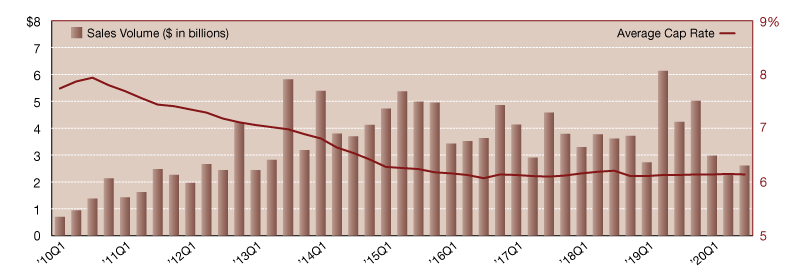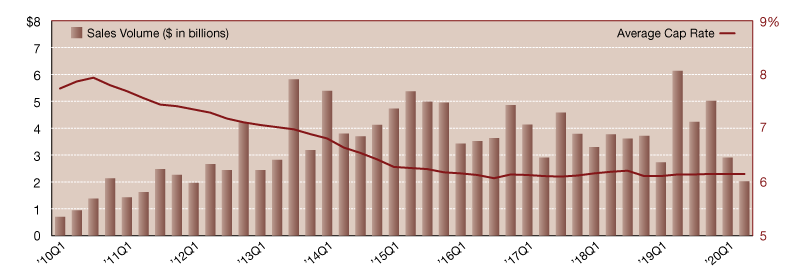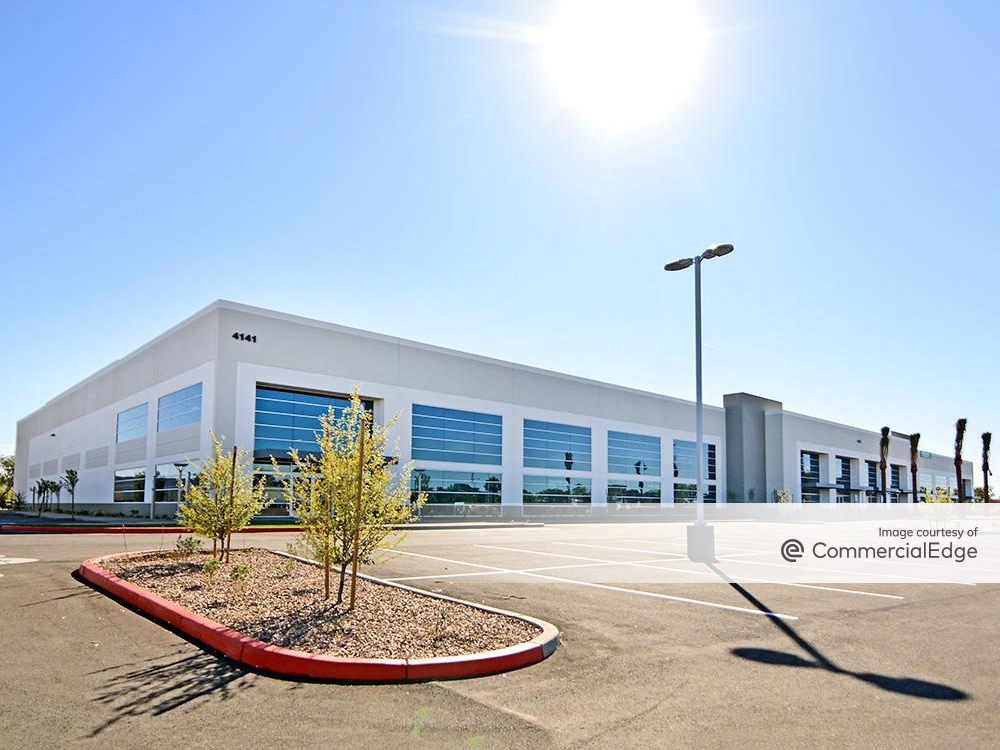2020 Net Lease Retail Sales Volume & Cap Rates
Slower-than-average demand has impacted the single-tenant net lease retail sector in 2020.
Slower-than-average demand has impacted the single-tenant net lease retail sector in 2020. Investment sales volume has failed to surpass the $3.0-billion-mark in each quarter this year, and for the first time since 2011, the sector is not expected to reach $10.0 billion in annual sales. Although it seems like disappointing news, investment activity across the net lease retail sector has certainly not halted. Demand continues to be strong for a number of property types, including drugstores, dollar stores, gas stations and convenience stores, freestanding groceries, and other essential retailers. In response to COVID-19, we’re also seeing some tenant brands reinvent their concepts, especially in the quick service restaurant space, and future development will bode well for investors. Cap rates in the net lease retail market have remained essentially unchanged for years, as they ended third quarter 2020 at 6.1 percent. Pending direct outside influences, average cap rates in the single-tenant retail sector are not expected to see drastic movement in the near term.
Focusing on business development, industry and client-specific research, and the analysis of local and national market trends, Lanie Beck has been the Director of Research for Stan Johnson Co. since 2013.
—Posted on Nov. 19, 2020
After a very strong 2019, the single-tenant net lease retail sector has seen two consecutive quarters of declining investment sales volume. Year-to-date totals are just shy of $5.0 billion, putting the sector on pace to reach totals not seen since 2012. While deals continue to close and new supply is hitting the market at a record pace, we’re not likely to see substantial increases in sales volume in the second half of 2020, although investor demand is currently quite strong. Buyers in this environment are cautious though, and many are risk adverse, choosing to pursue only the highest quality assets in the best locations. Investor demand for non-essential retailers has dwindled, although strong credit tenants continue to trade despite their non-essential status. Even with the current marketplace volatility, net lease cap rates in the retail sector have held remarkably steady. We’ve seen virtually no movement in the last five years, and average cap rates ended mid-year 2020 at 6.2 percent–a meager three basis points below year-end 2015’s average.
Focusing on business development, industry and client-specific research, and the analysis of local and national market trends, Lanie Beck has been the Director of Research for Stan Johnson Co. since 2013.
—Posted on Aug. 21, 2020
The single-tenant net lease retail sector reported strong and significant activity during much of 2019, including posting a record high $6.1 billion of investment sales during Q2 2019. Unfortunately, that level of demand was not able to be sustained going into 2020, as the first three months of the year saw the retail sector post its slowest quarter of activity since the start of 2013.
With only $2.4 billion in Q1 sales, the net lease retail sector will be unlikely to post annual totals that match recent years. In fact, depending on the duration of the current health crisis, the single-tenant retail market may be on track to post a sub-$10.0 billion year. Despite the volatility in the marketplace, net lease retail cap rates have remained virtually unchanged. Q1 2020 saw average cap rates increase a single basis point quarter-to-quarter, ending the period at 6.2 percent which is near the record low of 6.1 percent set in the latter half of 2016. Despite some upward movement since bottoming out, some regions of the country are still seeing incredibly low average cap rates, including the Northeast and West regions, which continue to report average rates between 5.7 and 5.8 percent.
Focusing on business development, industry- and client-specific research, and the analysis of local and national market trends, Lanie Beck has led Stan Johnson Co.’s research department since 2013 and has overseen corporate communications since 2018.
—Posted on May 22, 2020










You must be logged in to post a comment.